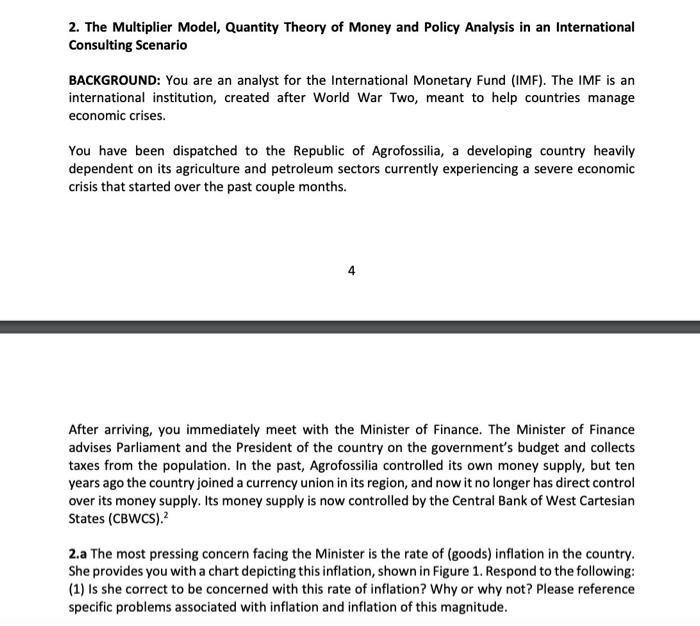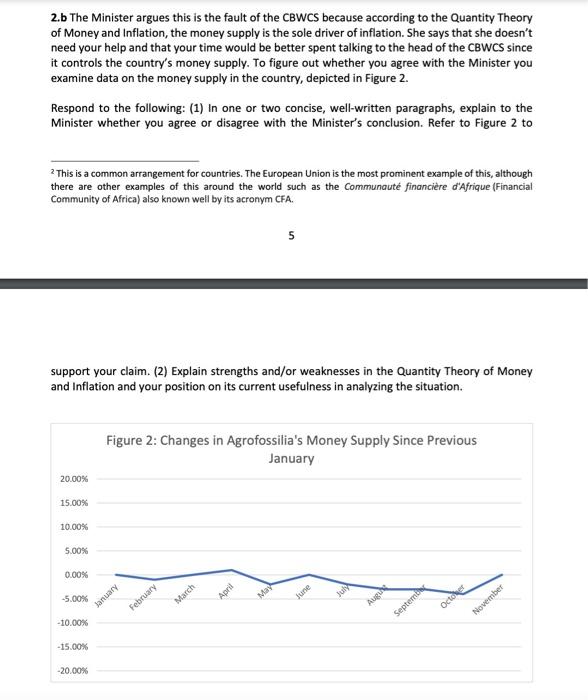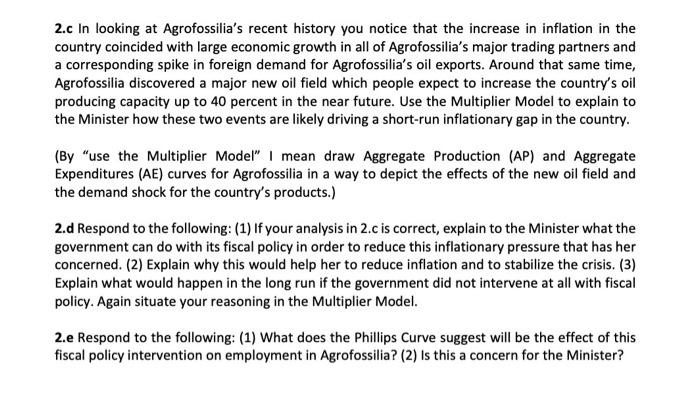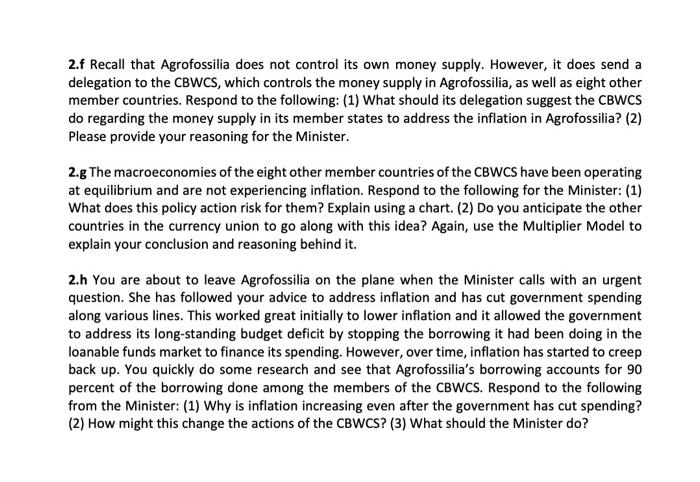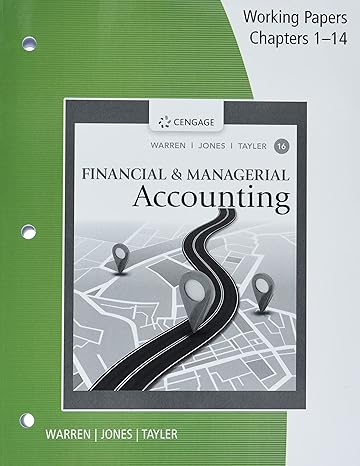2. The Multiplier Model, Quantity Theory of Money and Policy Analysis in an International Consulting Scenario BACKGROUND: You are an analyst for the International Monetary Fund (IMF). The IMF is an international institution, created after World War Two, meant to help countries manage economic crises. You have been dispatched to the Republic of Agrofossilia, a developing country heavily dependent on its agriculture and petroleum sectors currently experiencing a severe economic crisis that started over the past couple months. 4 After arriving, you immediately meet with the Minister of Finance. The Minister of Finance advises Parliament and the President of the country on the government's budget and collects taxes from the population. In the past, Agrofossilia controlled its own money supply, but ten years ago the country joined a currency union in its region, and now it no longer has direct control over its money supply. Its money supply is now controlled by the Central Bank of West Cartesian States (CBWCS). 2.a The most pressing concern facing the Minister is the rate of (goods) inflation in the country. She provides you with a chart depicting this inflation, shown in Figure 1. Respond to the following: (1) Is she correct to be concerned with this rate of inflation? Why or why not? Please reference specific problems associated with inflation and inflation of this magnitude. 2.a The most pressing concern facing the Minister is the rate of (goods) inflation in the country. She provides you with a chart depicting this inflation, shown in Figure 1. Respond to the following: (1) Is she correct to be concerned with this rate of inflation? Why or why not? Please reference specific problems associated with inflation and inflation of this magnitude. Figure 1: Inflation Rate in Agrofossilia since Previous January 1600% 1400% 1200% 1000% 800% 600% 400% 200% 0% April May June July March October September January Augu November February 2.b The Minister argues this is the fault of the CBWCS because according to the Quantity Theory of Money and Inflation, the money supply is the sole driver of inflation. She says that she doesn't need your help and that your time would be better spent talking to the head of the CBWCS since it controls the country's money supply. To figure out whether you agree with the Minister you examine data on the money supply in the country, depicted in Figure 2. Respond to the following: (1) In one or two concise, well-written paragraphs, explain to the Minister whether you agree or disagree with the Minister's conclusion. Refer to Figure 2 to 2 This is a common arrangement for countries. The European Union is the most prominent example of this, although there are other examples of this around the world such as the Communaut financire d'Afrique (Financial Community of Africa) also known well by its acronym CFA. 5 support your claim. (2) Explain strengths and/or weaknesses in the Quantity Theory of Money and Inflation and your position on its current usefulness in analyzing the situation. Figure 2: Changes in Agrofossilia's Money Supply Since Previous January 20.00% 15.00% 10.00% 5.00% 0.00% April -5.00% May June Jul AN January March February Oct September vember -10.00% -15.00% -20.00% 2.c In looking at Agrofossilia's recent history you notice that the increase in inflation in the country coincided with large economic growth in all of Agrofossilia's major trading partners and a corresponding spike in foreign demand for Agrofossilia's oil exports. Around that same time, Agrofossilia discovered a major new oil field which people expect to increase the country's oil producing capacity up to 40 percent in the near future. Use the Multiplier Model to explain to the Minister how these two events are likely driving a short-run inflationary gap in the country. (By use the Multiplier Model | mean draw Aggregate Production (AP) and Aggregate Expenditures (AE) curves for Agrofossilia in a way to depict the effects of the new oil field and the demand shock for the country's products.) 2.d Respond to the following: (1) If your analysis in 2.c is correct, explain to the Minister what the government can do with its fiscal policy in order to reduce this inflationary pressure that has her concerned. (2) Explain why this would help her to reduce inflation and to stabilize the crisis. (3) Explain what would happen in the long run if the government did not intervene at all with fiscal policy. Again situate your reasoning in the Multiplier Model. 2.e Respond to the following: (1) What does the Phillips Curve suggest will be the effect of this fiscal policy intervention on employment in Agrofossilia? (2) Is this a concern for the Minister? 2.f Recall that Agrofossilia does not control its own money supply. However, it does send a delegation to the CBWCS, which controls the money supply in Agrofossilia, as well as eight other member countries. Respond to the following: (1) What should its delegation suggest the CBWCS do regarding the money supply in its member states to address the inflation in Agrofossilia? (2) Please provide your reasoning for the Minister. 2.g The macroeconomies of the eight other member countries of the CBWCs have been operating at equilibrium and are not experiencing inflation. Respond to the following for the Minister: (1) What does this policy action risk for them? Explain using a chart. (2) Do you anticipate the other countries in the currency union to go along with this idea? Again, use the Multiplier Model to explain your conclusion and reasoning behind it. 2.h You are about to leave Agrofossilia on the plane when the Minister calls with an urgent question. She has followed your advice to address inflation and has cut government spending along various lines. This worked great initially to lower inflation and it allowed the government to address its long-standing budget deficit by stopping the borrowing it had been doing in the loanable funds market to finance its spending. However, over time, inflation has started to creep back up. You quickly do some research and see that Agrofossilia's borrowing accounts for 90 percent of the borrowing done among the members of the CBWCS. Respond to the following from the Minister: (1) Why is inflation increasing even after the government has cut spending? (2) How might this change the actions of the CBWCS? (3) What should the Minister do? 2. The Multiplier Model, Quantity Theory of Money and Policy Analysis in an International Consulting Scenario BACKGROUND: You are an analyst for the International Monetary Fund (IMF). The IMF is an international institution, created after World War Two, meant to help countries manage economic crises. You have been dispatched to the Republic of Agrofossilia, a developing country heavily dependent on its agriculture and petroleum sectors currently experiencing a severe economic crisis that started over the past couple months. 4 After arriving, you immediately meet with the Minister of Finance. The Minister of Finance advises Parliament and the President of the country on the government's budget and collects taxes from the population. In the past, Agrofossilia controlled its own money supply, but ten years ago the country joined a currency union in its region, and now it no longer has direct control over its money supply. Its money supply is now controlled by the Central Bank of West Cartesian States (CBWCS). 2.a The most pressing concern facing the Minister is the rate of (goods) inflation in the country. She provides you with a chart depicting this inflation, shown in Figure 1. Respond to the following: (1) Is she correct to be concerned with this rate of inflation? Why or why not? Please reference specific problems associated with inflation and inflation of this magnitude. 2.a The most pressing concern facing the Minister is the rate of (goods) inflation in the country. She provides you with a chart depicting this inflation, shown in Figure 1. Respond to the following: (1) Is she correct to be concerned with this rate of inflation? Why or why not? Please reference specific problems associated with inflation and inflation of this magnitude. Figure 1: Inflation Rate in Agrofossilia since Previous January 1600% 1400% 1200% 1000% 800% 600% 400% 200% 0% April May June July March October September January Augu November February 2.b The Minister argues this is the fault of the CBWCS because according to the Quantity Theory of Money and Inflation, the money supply is the sole driver of inflation. She says that she doesn't need your help and that your time would be better spent talking to the head of the CBWCS since it controls the country's money supply. To figure out whether you agree with the Minister you examine data on the money supply in the country, depicted in Figure 2. Respond to the following: (1) In one or two concise, well-written paragraphs, explain to the Minister whether you agree or disagree with the Minister's conclusion. Refer to Figure 2 to 2 This is a common arrangement for countries. The European Union is the most prominent example of this, although there are other examples of this around the world such as the Communaut financire d'Afrique (Financial Community of Africa) also known well by its acronym CFA. 5 support your claim. (2) Explain strengths and/or weaknesses in the Quantity Theory of Money and Inflation and your position on its current usefulness in analyzing the situation. Figure 2: Changes in Agrofossilia's Money Supply Since Previous January 20.00% 15.00% 10.00% 5.00% 0.00% April -5.00% May June Jul AN January March February Oct September vember -10.00% -15.00% -20.00% 2.c In looking at Agrofossilia's recent history you notice that the increase in inflation in the country coincided with large economic growth in all of Agrofossilia's major trading partners and a corresponding spike in foreign demand for Agrofossilia's oil exports. Around that same time, Agrofossilia discovered a major new oil field which people expect to increase the country's oil producing capacity up to 40 percent in the near future. Use the Multiplier Model to explain to the Minister how these two events are likely driving a short-run inflationary gap in the country. (By use the Multiplier Model | mean draw Aggregate Production (AP) and Aggregate Expenditures (AE) curves for Agrofossilia in a way to depict the effects of the new oil field and the demand shock for the country's products.) 2.d Respond to the following: (1) If your analysis in 2.c is correct, explain to the Minister what the government can do with its fiscal policy in order to reduce this inflationary pressure that has her concerned. (2) Explain why this would help her to reduce inflation and to stabilize the crisis. (3) Explain what would happen in the long run if the government did not intervene at all with fiscal policy. Again situate your reasoning in the Multiplier Model. 2.e Respond to the following: (1) What does the Phillips Curve suggest will be the effect of this fiscal policy intervention on employment in Agrofossilia? (2) Is this a concern for the Minister? 2.f Recall that Agrofossilia does not control its own money supply. However, it does send a delegation to the CBWCS, which controls the money supply in Agrofossilia, as well as eight other member countries. Respond to the following: (1) What should its delegation suggest the CBWCS do regarding the money supply in its member states to address the inflation in Agrofossilia? (2) Please provide your reasoning for the Minister. 2.g The macroeconomies of the eight other member countries of the CBWCs have been operating at equilibrium and are not experiencing inflation. Respond to the following for the Minister: (1) What does this policy action risk for them? Explain using a chart. (2) Do you anticipate the other countries in the currency union to go along with this idea? Again, use the Multiplier Model to explain your conclusion and reasoning behind it. 2.h You are about to leave Agrofossilia on the plane when the Minister calls with an urgent question. She has followed your advice to address inflation and has cut government spending along various lines. This worked great initially to lower inflation and it allowed the government to address its long-standing budget deficit by stopping the borrowing it had been doing in the loanable funds market to finance its spending. However, over time, inflation has started to creep back up. You quickly do some research and see that Agrofossilia's borrowing accounts for 90 percent of the borrowing done among the members of the CBWCS. Respond to the following from the Minister: (1) Why is inflation increasing even after the government has cut spending? (2) How might this change the actions of the CBWCS? (3) What should the Minister do
